When I first began delving into making herbal bath and beauty products myself many years ago, it all started with homemade herbal deodorant. It’s the perfect beginner recipe for DIY beauty products, mainly because it’s simple to make, but also because it’s good for your health. The best part is that this homemade deodorant recipe really works!
Why Make Your Own Deodorant?
But why make your own deodorant you ask? Because regular store bought deodorant is full of ingredients that are very questionable to say the least. Have you ever looked at the ingredient list? I suggest checking it out and you’ll see what I mean.
I know you’re not eating the stuff, but all those chemicals do get into your body through your skin. There have also been studies that show that aluminum in antiperspirants may cause breast cancer. I don’t know about you, but I don’t want to mess around with that.
What Goes in Homemade Deodorant?
The first homemade deodorant I made is the most common one you’ll find on the internet, with coconut oil, baking soda, arrowroot or cornstarch, and essential oils. It works ok, but needs to be put into a jar and applied with your fingertips as it’s too soft for a normal deodorant container.
The bummer about it is when it’s hot out it turns almost to a complete liquid, with the baking soda and arrowroot/cornstarch settling at the bottom.
That’s where this recipe is different, as it adds beeswax and shea butter to make the whole thing a thicker consistency so that it will hold up in an actual deodorant container or in a half circle mold, making for much easier application.
Beeswax is beneficial in homemade deodorant recipes because it’s naturally antiseptic, antibacterial, emollient, and hydrating to the skin. Vegans can try using carnauba wax in place of the beeswax to get the same results, but less will be needed as it’s a harder wax.
Arrowroot powder and baking soda are added for their natural deodorizing effect. If you are sensitive to baking soda in your deodorant it can be omitted, just replace with more arrowroot powder.
Essential oils make the deodorant smell good while also adding some antimicrobial, antibacterial, and antifungal properties.
I like to use an herbal infused blend of coconut oil and sweet almond oil for this deodorant recipe. Coconut oil is antimicrobial and antifungal, and sweet almond oil is light and absorbs easily into the skin, so there is minimal oil residue left after applying.
Herbs to Use for Homemade Deodorant
Lavender and sage are excellent for making herbal deodorant. Lavender is often used in skin care products due to germ fighting benefits and its pleasing scent. Sage is amazing in that it has some natural antiperspirant properties.
There are many other herbs you could choose depending on your preferences. Some good options are rosemary, mint, calendula, oregano, marshmallow root, yarrow, rose, chamomile, and lemon balm.
My favorite place to get high quality, organic dried herbs is Mountain Rose Herbs.
Homemade Deodorant Recipe with Lavender and Sage
The first step in this recipe is to make an infused herbal oil with lavender and sage, or any other herbs of your choice.
For the Infused Herbal Oil
Fill a half pint canning jar about ⅔ full of dried lavender and sage leaf. Melt ¼ cup of coconut oil in a saucepan on the stove over low heat, then pour over the dried herbs. Then add sweet almond oil to fill the jar.
Cover the jar and put in a cool and dark place to infuse for 2-6 weeks (the longer the better). Strain out the herbal material with a fine mesh sieve when ready to use.
For the Deodorant
Ingredients
- ½ cup herb infused oil (see above)
- 2 ounces beeswax
- 1 ounce shea butter
- 20-30 drops essential oils of your choice (I like to use 10 drops each of lavender, sage, and sweet orange)
- 2 tablespoons arrowroot powder
- 2 teaspoons baking soda (optional, replace with more arrowroot if you omit)
Instructions
- Put the infused oil and beeswax into the top container of a double boiler, and stir as the beeswax melts. (Tip: you can make a double boiler with a smaller pot, bowl, or a glass Pyrex measuring cup over an inch or so of simmering water. If you use glass Pyrex, put something in the bottom of the pot that it can rest on, such as a canning jar lid).
- Once the beeswax has completely melted, add the shea butter and stir until it dissolves.
- Remove the mixture from the double boiler and stir in the essential oils, then stir in the arrowroot powder and baking soda. Keep stirring for a minute or two to thoroughly combine. The mixture will begin to thicken slightly.
- Pour the mixture into empty deodorant containers or half circle molds. Let the deodorant set up for a few hours before using.
This recipe makes about 8 ounces of deodorant in total.
This is what it looks like when everything is stirred together right before pouring it into the deodorant container or mold. It has thickened slightly, but is still pourable.
I really like using the half circle mold for homemade deodorant. (You could also use these molds for making lotion bars.) I keep the finished deodorant in a large tin and it works perfectly!
It’s really amazing how well this herbal deodorant works! I really suggest you give it a try, even if you’ve had trouble with homemade deodorants in the past. The lavender and sage combination are highly effective and smell very nice.
This is absolutely my favorite recipe for deodorant, and I’m so happy to be ditching the store bought stuff for good!
Homemade Deodorant with Sage and Lavender
Equipment
Ingredients
Infused Herbal Oil
- 1/3 cup sage leaves
- 1/3 cup dried lavender
- 1/4 cup coconut oil
- 2/3 cup sweet almond oil (approximately)
Homemade Deodorant
- 1/2 cup infused herbal oil
- 2 ounces beeswax
- 1 ounce shea butter
- 20-30 drops essential oil I like to use 10 drops each of lavender, sage, and sweet orange
- 2 Tablespoons arrowroot powder
- 2 teaspoons baking soda optional or substitute with more arrowroot powder
Instructions
Infused Herbal Oil
- Place the herbs in a half pint mason jar.
- Melt the coconut oil over low heat.
- Add the coconut oil to the jar of herbs and then fill the jar the rest of the way with sweet almond oil.
- Cover the jar and put in a cool and dark place to infuse for 2-6 weeks (the longer the better).
- Strain out the herbal material with a fine mesh sieve when ready to use.
Homemade Deodorant
- Put the infused oil and beeswax into the top container of a double boiler, and stir as the beeswax melts.
- Once the beeswax has completely melted, add the shea butter and stir until it dissolves.
- Remove the mixture from the double boiler and stir in the essential oils, then stir in the arrowroot powder and baking soda. Keep stirring for a minute or two to thoroughly combine. The mixture will begin to thicken slightly.
- Pour the mixture into empty deodorant containers or half circle molds. Let the deodorant set up for a few hours before using.
Notes






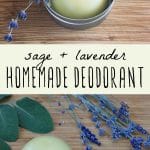
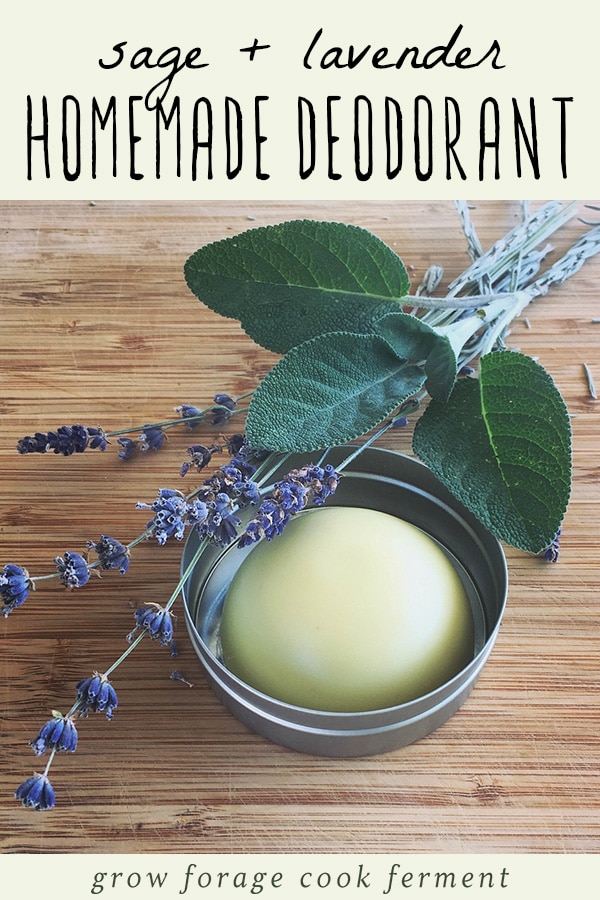
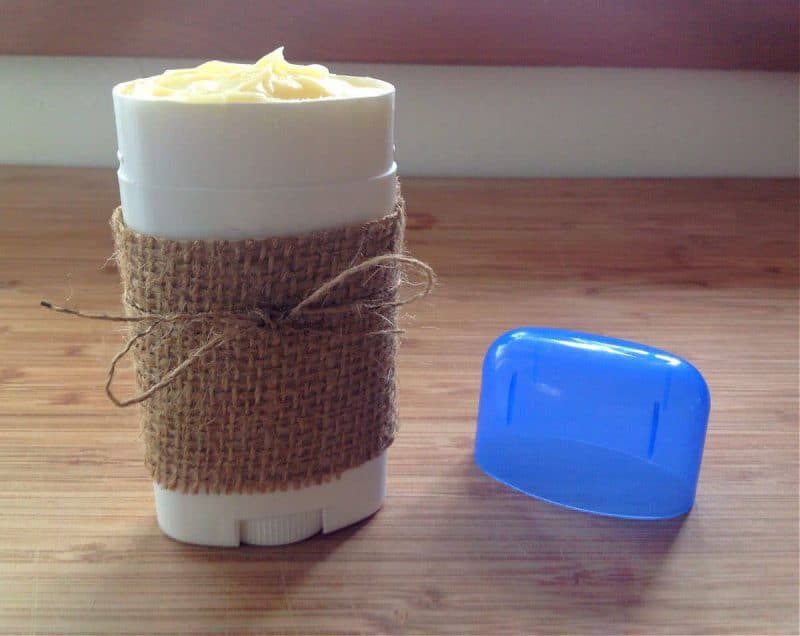
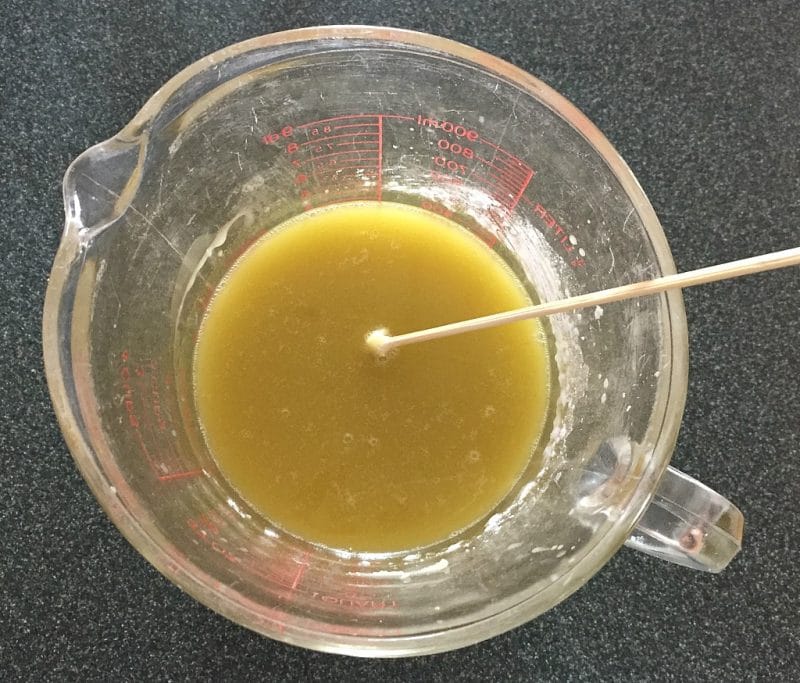

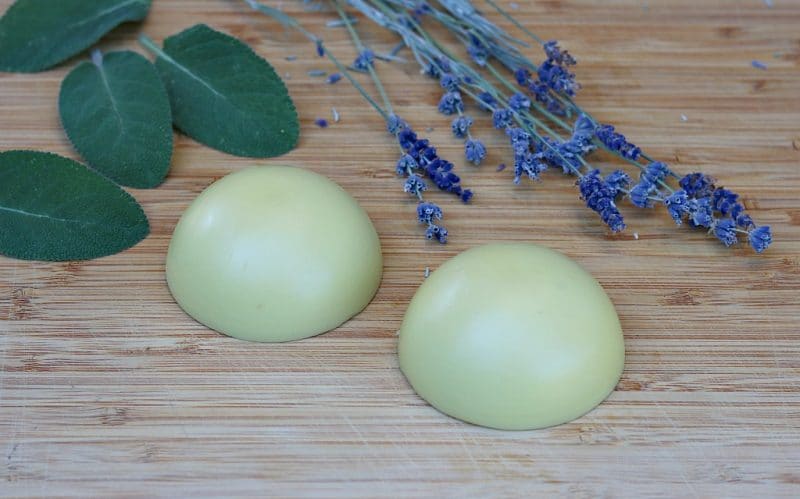


Can I substitute the Shea butter for cocoa butter? Would that effect it in anyway? Thanks
Nope. That’s totally fine, Amanda!
Hi there! I was wondering, with this recipe would this deodorant expired after a certain time or could it be made and stored for long term storage (5-10 years?). Thanks!
Hi Meghann. That’s a really good question and one I’m not sure how to answer. Coconut oil has a shelf life of 2 years before it becomes rancid. I imagine if your deodorant is refrigerated or kept in a cool environment, you could extend its life beyond those 2 years.
Hello! I was wondering if it’s possible to use the “quick method” (by heating the oil and dried flowers in a pot on low heat for some hours.) in this recipe?
Yes, you can do that.
Hi,
It isn’t clear if all the herbs are dried, or fresh. I would like to use sage and rosemary. Do they need to be dried.
Yes, both of your herbs should be dried so that they don’t leach any moisture into your infused oil.
Curious if the sage leaf & dried lavender are washed after harvest? Hoping it doesn’t matter.
Hi, Dana. It doesn’t really matter, but you could rinse it if it needs it.
Hey I want to try that. I love diy balms and such
Sarah, I mixed jasmine, lavender, and lemon grass and also took the advice to add extra baking soda (1 teaspoon extra). I too struggle with severe body odor sometimes. So far this combination seems to be working. Smells good to me too.
Thanks so much for the recipe.I’m a newbie to diy soaps and balms. Any tips on anything is very helpful to me.
You’re welcome.
Hello! I’d be much obliged if you clarified whether the Oz. are fluid or by weight??
I’m in Canada and I’m confused lol!
Thank you!
Hi Julia. Sorry for the confusion! The measurements are by weight.
Hello colleen! I would like to make this recipe for my daughter, but she is allergic to anything coconut. I often switch out avacado oil for coconut oil in salve recipes, but I’m wondering if I would need to add more beeswax to help with the consistency of the deodorant. I’m concerned that it would end up being too soft. Any suggestions?? Thanks so much 😄
Hi, Anne! You could try upping the beeswax in the recipe. Another alternative is tallow. Tallow is super nourishing for the skin and stays solid at room temperature.
Thanks!!!!
questions about the herbal-infused oil: in the past, when i’ve attempted to infuse coconut oil and mixed it with a non-solid oil ( usually grapeseed), it STILL firms up 1)are the herbs still infusing even though it’s solid? 2) should i be using a different oil rather than grapeseed?
CHEERS
I typically use high quality, light olive oil as my carrier oil of choice, but there’s nothing wrong with using grapeseed. I prefer to make a blend of olive, sweet almond, and coconut oil (like I did in this recipe for calendula salve) and it doesn’t firm up too much. If it does, however, I may set in a sunny window for a bit to remelt the oils.
This sounds lovely! I can’t wait to try it out- thanks :)
You’re welcome, Beth!
For people who need something stronger for really stinky type sweat: try tea tree oil. It’s the only natural ingredient I have found that works for me.
Sadly this did not work for me, I absolutely stink of sweat lol 😩! Can I melt the mixture and try to add something…suggestions please? Thanks
Hi Sarah, sorry this didn’t work for you! It is still my favorite deodorant. Did you use the baking soda and/or arrowroot powder? You could try adding a little more of those to help deodorize, but go easy on the baking soda as it can cause skin reactions in some people. There are also some natural clays that can be added to help absorb odors. Also, if you do melt it down again, it may have a grainier texture once it rehardens, but it should still be usable.
Hello.I would like to ask if olive oil can be used in making herbal oil? And what is the difference between olive oil and almond and coconut oil? Thank you!
Yes, I frequently use olive oil in my herbal products. It’s just my preference to use coconut and almond oil, but you could totally use only olive oil if you’d like.